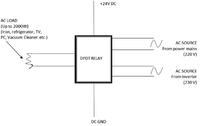rrlamichhane
Newbie level 3
I'm constructing a circuit which conducts 'line A' when '24' DC voltage is applied to Relay and conducts 'line B' when the DC voltage is absent. The switching speed is not that significant and Relay would do the job. This can be very easily accomplished by the use of Relay, I know that. But would Triac be more durable than Relay. I circuit will need to conducts at least 10A in 230V AC.
What would be the advantages of Triac if it can be used in this circuit without impairing its functionalities? Also, which Triac would be most suitable for this purpose?
What would be the advantages of Triac if it can be used in this circuit without impairing its functionalities? Also, which Triac would be most suitable for this purpose?
